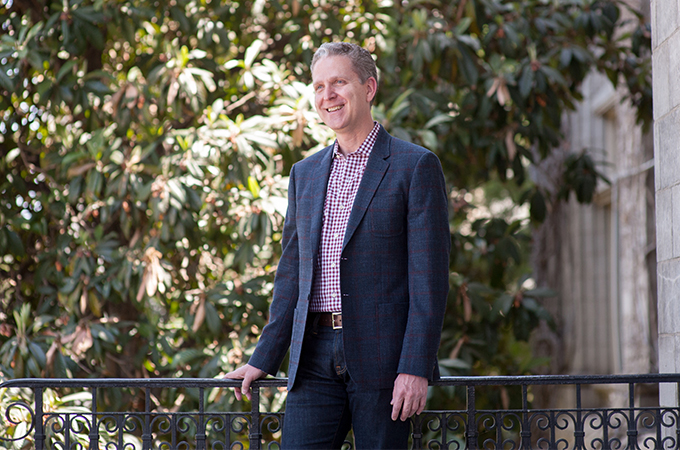Mark Gilbert ’17 didn’t find his passion for spatial studies until he was 48, “but I was always a late bloomer,” he said.
At the time, he already put in 15 years as an application programmer and analyst for the City of Berkeley. Gilbert worked for the city’s police and fire department in information technology system support. “I loved my job,” he said. “That’s where I was first introduced to geographic information science (GIS), through the computer-aided dispatch system. The 911 call system was all based on GIS.”
Gilbert, who majored in aerospace engineering and worked with tech startups during the first dot-com boom in the 1990s, knew he wanted to get an advanced degree, but was never quite sure what to study. One day, he came upon an ad for the University of Redlands MS GIS program in ArcUser Magazine. After finding out he could get his MS GIS in one year, he was sold.
“In using the tools and learning about what GIS was [at my job in public safety], I realized that there was a connection between data and location,” he said. “I love being in the data and figuring out what it says, so I’m always trying to figure out, ‘What does this all mean?’”
Today, Gilbert creates software as one of Esri’s population data scientists. His work helps governments deliver health or human services to their citizens, work on environmental missions, or allocate budgets. It’s work that fulfills part of Gilbert’s personal mission and gives him a reason to be excited to go to work each day: “We’re mapping where people are to promote a safer, healthier, and more sustainable planet.”
Going back to being a student at 48 was a piece of cake, Gilbert says, especially because his husband was able to support him financially while he studied full time. “School was a treat and a pleasure, and I knew that if I didn’t do the absolute best that I could, it would be my own fault. So I totally dove into it.”
Gilbert, whose previous university experience was at large state schools, said he was “absolutely thrilled and satisfied” at U of R. “[The University of Redlands] is the perfect size—you really get to know your classmates, and you’re really taken care of, from the administrative aspects to the classes. At my age, I appreciated it so much more.”
In his coursework, Gilbert sought to connect his academic experiences with his personal ones. For his capstone (major individual project), he worked with a film and television production location scout and built a web-based app for the City of Palm Springs. It gave location scouts the information needed—such as square footage, maximum capacity, parking—to shoot films or TV shows, while building on his love of Hollywood and films. “Having that connection between my academic experience and film and television production was a win-win,” he said.
His work paid off; in 2016, Gilbert won the U of R’s Roger Tomlinson Award for Excellence in GIS, which recognizes strong research and academic capabilities in the field.
As a Redlands alumnus who now works at Esri, Gilbert appreciates the University’s strong connection to the biggest GIS software company in the world and to the Redlands community. “If you're a GIS professional and you really want to be close to the source, Redlands is the place to be,” he said. “[Students in] the MS GIS program get to use the latest and greatest versions of Esri software and the training is provided by Esri professionals. You are working with faculty members from Esri; they’re seeing your work and giving you feedback. You still have to perform at your best and deliver, but when the course is done, they have a pretty good idea of what you’re going to be like in a professional environment. That's worth its weight in gold.”
Learn more about spatial studies at the University of Redlands.






